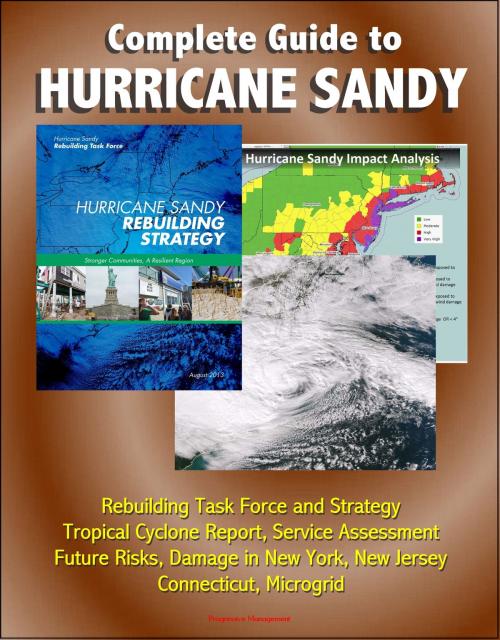Complete Guide to Hurricane Sandy: Rebuilding Task Force and Strategy, Tropical Cyclone Report, Service Assessment, Future Risks, Damage in New York, New Jersey, Connecticut, Microgrid
Nonfiction, Science & Nature, Science, Other Sciences, Meteorology, Social & Cultural Studies, Social Science| Author: | Progressive Management | ISBN: | 9781301464210 |
| Publisher: | Progressive Management | Publication: | August 30, 2013 |
| Imprint: | Smashwords Edition | Language: | English |
| Author: | Progressive Management |
| ISBN: | 9781301464210 |
| Publisher: | Progressive Management |
| Publication: | August 30, 2013 |
| Imprint: | Smashwords Edition |
| Language: | English |
This comprehensive ebook provides authoritative rebuilding and recovery information, plus detailed historical meteorological data, about Hurricane Sandy. This compilation features the recently released major federal report on rebuilding and recovery, the Sandy Rebuilding Task Force chaired by HUD Secretary Shaun Donovan, plus reports and material from the National Hurricane Center and National Weather Service analyzing the science of the storm.
Superstorm Sandy caused catastrophic damage and many human casualties when it struck the East Coast of the United States on October 29, 2012. Sandy damaged or destroyed at least 650,000 houses and left approximately 8.5 million customers without power during the storm and its aftermath. The effects of Sandy extended as far west as Wisconsin. This late season storm also generated blizzard conditions in western North Carolina and West Virginia, resulting in snowfall totals as high as 3 feet. Storm surge created some of the most devastating impacts, including flooding in New York City's subway tunnels, water overtopping runways at La Guardia and Kennedy airports, and damage to the New Jersey Transit System estimated at approximately $400 million. Hurricane/Post-tropical Cyclone Sandy was unique in many ways. Its historically unprecedented track approached New Jersey and New York from the east; storms typically approach from the south. Sandy also made an atypical transition to post-tropical status. The storm evolved when a tropical cyclone merged with an intense low pressure system and dramatically increased in size before landfall. Sandy was the deadliest hurricane to hit the U.S. mainland since Hurricane Katrina in 2005, as well as the deadliest hurricane/post-tropical cyclone to hit the U.S. East Coast since Hurricane Agnes in 1972.
Contents:
Part 1: Hurricane Sandy Rebuilding Task Force
Part 2: Tropical Cyclone Report - Hurricane Sandy (NHC)
Part 3: Service Assessment Hurricane/Post-Tropical Cyclone Sandy (NOAA/NWS)
Part 4: New England Effects from the Hurricane Sandy Hybrid Storm
At the peak of the response, the Federal Government mobilized more than 17,000 volunteers in the affected areas, and more than $200 million in Federal services and resources were provided to address immediate recovery needs. The President recognized that, in addition to the immediate aid response, it was vital to have a Cabinet-level team focused on long-term rebuilding, working closely with the Federal Emergency Management Agency (FEMA) and the organizations put in place by the National Disaster Recovery Framework (NDRF) to remove obstacles to resilient rebuilding and promote the long-term sustainability of communities and ecosystems. In response to the crisis, and because of the scope of the impact and the need for the highest level of coordination for recovery, President Obama created the Hurricane Sandy Rebuilding Task Force (the Task Force) in December of 2012, and designated the Secretary of Housing and Urban Development (HUD), Shaun Donovan, as Chair. The additional members were the heads of twenty-three executive department agencies and offices.
This comprehensive ebook provides authoritative rebuilding and recovery information, plus detailed historical meteorological data, about Hurricane Sandy. This compilation features the recently released major federal report on rebuilding and recovery, the Sandy Rebuilding Task Force chaired by HUD Secretary Shaun Donovan, plus reports and material from the National Hurricane Center and National Weather Service analyzing the science of the storm.
Superstorm Sandy caused catastrophic damage and many human casualties when it struck the East Coast of the United States on October 29, 2012. Sandy damaged or destroyed at least 650,000 houses and left approximately 8.5 million customers without power during the storm and its aftermath. The effects of Sandy extended as far west as Wisconsin. This late season storm also generated blizzard conditions in western North Carolina and West Virginia, resulting in snowfall totals as high as 3 feet. Storm surge created some of the most devastating impacts, including flooding in New York City's subway tunnels, water overtopping runways at La Guardia and Kennedy airports, and damage to the New Jersey Transit System estimated at approximately $400 million. Hurricane/Post-tropical Cyclone Sandy was unique in many ways. Its historically unprecedented track approached New Jersey and New York from the east; storms typically approach from the south. Sandy also made an atypical transition to post-tropical status. The storm evolved when a tropical cyclone merged with an intense low pressure system and dramatically increased in size before landfall. Sandy was the deadliest hurricane to hit the U.S. mainland since Hurricane Katrina in 2005, as well as the deadliest hurricane/post-tropical cyclone to hit the U.S. East Coast since Hurricane Agnes in 1972.
Contents:
Part 1: Hurricane Sandy Rebuilding Task Force
Part 2: Tropical Cyclone Report - Hurricane Sandy (NHC)
Part 3: Service Assessment Hurricane/Post-Tropical Cyclone Sandy (NOAA/NWS)
Part 4: New England Effects from the Hurricane Sandy Hybrid Storm
At the peak of the response, the Federal Government mobilized more than 17,000 volunteers in the affected areas, and more than $200 million in Federal services and resources were provided to address immediate recovery needs. The President recognized that, in addition to the immediate aid response, it was vital to have a Cabinet-level team focused on long-term rebuilding, working closely with the Federal Emergency Management Agency (FEMA) and the organizations put in place by the National Disaster Recovery Framework (NDRF) to remove obstacles to resilient rebuilding and promote the long-term sustainability of communities and ecosystems. In response to the crisis, and because of the scope of the impact and the need for the highest level of coordination for recovery, President Obama created the Hurricane Sandy Rebuilding Task Force (the Task Force) in December of 2012, and designated the Secretary of Housing and Urban Development (HUD), Shaun Donovan, as Chair. The additional members were the heads of twenty-three executive department agencies and offices.















